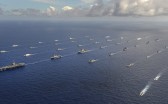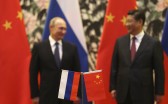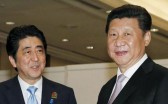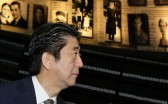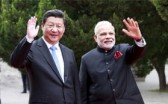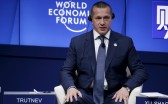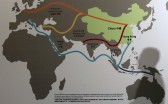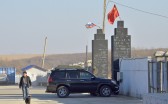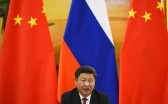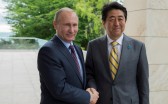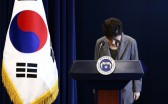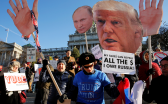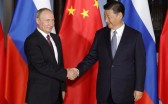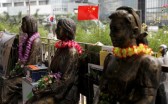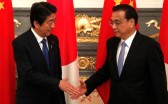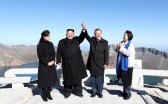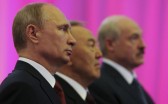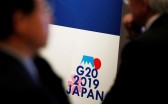In what is considered one of Pyongyang’s most potent propaganda events—a mass performance called the “Glorious Country”—Moon Jae-in addressed some 150,000 North Koreans, who erupted in teary applause as he proclaimed a “new era” of peace and prosperity. In his seven-minute-long speech, Moon implored the two Koreas to “end the past 70 years of hostility and take a big stride of peace to become one again.” For Moon, these images carried a critical message to both his domestic and international audience: The peace process is not dead.
Skeptics were quick to contend that the summit was a mere exercise in symbolism—that it had failed, because denuclearization remained a distant hope. In their preoccupation with denuclearization, however, they implied—falsely—that Seoul’s objectives were the same as those of Washington. In reality, seen from Moon’s standpoint, the Pyongyang summit was a timely—if impermanent—victory to consolidate support for his Nordpolitik and rescue the faltering nuclear diplomacy.
Why another summit?
The third inter-Korean summit of 2018 transpired amid growing pessimism in Washington about the value of engagement with Pyongyang. Despite its pledge to denuclearize, the North has continued to develop its Yongbyon nuclear facilities at an alarming pace.1 In another revelation, Seoul admitted that South Korean companies had illegally imported over 33,000 tons of North Korean coal between April and October of last year, in breach of the UN sanctions regime.2 As US-China tensions deepened over tariffs, suspicions of Chinese efforts to undermine Donald Trump’s “maximum pressure” campaign loomed large.3 With the initial spirit of optimism quickly waning, Trump canceled Secretary of State Mike Pompeo’s scheduled trip to North Korea, blaming the regime for insufficient progress on denuclearization and accusing China of secretly evading its UN sanctions obligations.
Against this backdrop, Moon entered another inter-Korean summit with a modest aim: taming Trump’s growing impatience and reviving the stalled diplomacy. Moon’s goal was limited largely by circumstance. He was acutely aware of the differences between Pyongyang and Washington on the definition and scope of denuclearization—a gap that, were he to bridge by picking a side, could cost his credibility as an intermediary. Likewise, Moon could not separate inter-Korean cooperation from the broader peace process; any expansive economic project would undermine the international sanctions regime that successive South Korean governments have worked painstakingly to build. These constraints explain in part why Moon’s diplomacy vis-à-vis Trump and Kim is (often unsatisfyingly) vague: Moon pushes for clarity only if it does not risk an appearance of partiality, which may undermine his legitimacy as the sensible broker. Fortunately for Moon, his restraint has enabled him to nurture a sufficient condition for the peace process to endure—at least so far.
What did Moon gain from the inter-Korean summit?
Considering Moon’s objectives and expectations, the inter-Korean summit was, for the most part, successful. For each of his audience—Trump, Kim, and his constituents in South Korea—Moon supplied a much-needed boost of confidence to sustain the ongoing dialogue.
First and most importantly, Moon convinced Trump to reconsider a second meeting with Kim. Although the North refused to provide an inventory of its nuclear arsenal—a concession Washington has long-demanded—Kim promised to allow international inspections at the shuttering of the missile test site at Tongchang-ri and hinted at his (conditional) willingness to dismantle the nuclear complex in Yongbyon. While these pledges have limited bearing on the North’s ability to advance its nuclear force (in particular its production of fissile material and ICBMs), they seem to have satisfied Trump’s need for reassurance. In his tweet, Trump hailed the outcomes of the Pyongyang summit as “very exciting.”4 Signaling the president’s approval, Pompeo also issued a statement expressing his desire to “immediately” resume talks with the North. Following his meeting with the North Korean foreign minister Ri Yong-ho on the sidelines of the UN General Assembly, he travelled to Pyongyang to discuss the details of the second Trump-Kim summit, depicting his conversation as “productive.”5
In resuscitating diplomacy, Moon not only defused Washington’s increasing frustration with Pyongyang but also played a more direct role in enabling its engagement. This is important for Seoul, which constantly fears “Korea-passing,” or any scenario in which a grand bargain is struck in its absence. The concern over Seoul’s marginalization became particularly prominent when Trump announced the suspension of US-South Korean military exercises during the Singapore summit. Though his unilateral decision happened to be a welcome surprise for Moon’s progressive government, the incident underscored Seoul’s dispensability and raised concerns about abandonment.6 In this sense, the recent nuclear deadlock provided Moon an opportunity-in-crisis to reestablish his role as a central figure in facilitating US-North Korean relations.
Second and more concretely, Moon refined the details of inter-Korean cooperation in both military and economic domains. The former is notable: the two Koreas signed an extensive military agreement (with a 17-page-long annex) that, inter alia, designates no-fly zones and bans various military exercises along the demilitarized zone (DMZ). In addition, it establishes a maritime buffer in the Yellow Sea and demolishes a number of heavily armed guard posts within the DMZ. Taken together, these steps allow the two Koreas to reduce the risk of a conventional conflict—whether by accident or miscalculation—that could spiral out of control. The Cheonan sinking and the bombardment of Yeonpyeong island in 2010, in particular, have reinforced for the South Korean public the danger of conventional military escalation. Even as the rest of the world is fixated on the North’s nuclear threat, a conventional fallout is a more real and immediate risk for Seoul. The military portion of the Pyongyang Declaration, therefore, delivers a tangible win for the Moon administration.
On the economic front, Moon proposed a bold expansion of cross-border projects including reconnecting railways and a reopening of the Kaesong industrial complex and Kumgang tourist zone. Many of these promises cannot be realized with current levels of sanctions against the North, but their inclusion in the Pyongyang Declaration is still useful to the extent that they raise Kim’s perceived benefits of cooperation. In April, Kim declared that the nuclear prong of his byungjin policy was complete and that he would devote himself to “socialist economic construction”—a new formulation that has since been persistently trumpeted in the regime’s propaganda.7 This explains why Moon is doubling down on the economic appeal of their rapprochement. Indeed, on his trip to Pyongyang, he brought with him leaders of South Korea’s top conglomerates—including Samsung, Hyundai, and LG—signaling that he is ready to support the North’s economic revival. This is part of Moon’s broader strategy to demonstrate to Kim how promising economic integration could be—should he denuclearize.
Finally, the summit bolstered Moon’s image as a seasoned diplomat and helped consolidate domestic support for his Nordpolitik. A sluggish economy had caused his approval rating to fall sharply—below 50 percent for the first time—as the summit approached. Renewed hostility between Washington and Pyongyang was doubly unhelpful: conservatives criticized inter-Korean détente as distracting from real troubles at home, amid widespread agreement from the public. Facing an unfavorable political climate, Moon’s summit objectives focused on generating images of high public relations value. His emotional speech at the mass games, broadcast live in South Korea, reinforced his narratives of peaceful reunification. In another symbolic move, Moon and Kim visited Mount Paektu—a central place in Korean mythology—which helped to rekindle public consciousness of the two Korea’s long shared history. Strengthening this image of reconciliation, the leaders also pledged to regularize family reunions and jointly bid for the 2032 Summer Olympic Games. The effects were immediate: Moon’s popularity rebounded to mid-60 percent—at a two-month high—and conservative opposition against inter-Korean diplomacy lost its growing traction.8 For Moon, this was a timely dose of optimism for his leadership abroad and at home.
Conclusion
Moon’s aim for the inter-Korean summit was to convince each of his audiences—Trump, Kim, and the South Korean public—that diplomacy should continue. In a recent interview, Moon stated, “[t]he plan is to make enough progress by the year’s end so the process cannot be reversed.” This suggests that his strategy for dealing with Pyongyang apropos Washington is to commit both parties to the peace process by increasing their stakes in cooperation, piece by piece, until eventually neither side can defect. This strategy appears appropriate for Moon given his aversion to push either side too strongly to make concessions—on denuclearization for North Korea and on sanctions for the United States. In fact, insofar as Moon’s overarching objective is to deepen Seoul’s engagement with Pyongyang without jeopardizing its relations with Washington, it is in his interest to keep creating an impression of progress (regardless of whether it is real) and to sustain the right atmospherics for the peace process. Assessed under these expectations, the outcomes of the Pyongyang summit present a far more affirmative picture for Seoul than what the US-centric accounts suggest.
To be sure, various factors may upend the current diplomatic momentum that Moon helped to rebuild, including, most importantly, how well Seoul can manage Washington’s expectations going forward. Already, signs of fragmentation are emerging. To Seoul’s alarm, the commander of the US-ROK Combined Forces recently barred the South Korean military from entering the DMZ to inspect the North’s railways.9 The incident highlighted how the implementation of the inter-Korean military agreement may hinge upon its ability to amend the character and scope of existing US-ROK military cooperation.10 Equally troubling, Washington’s insistence on the application of sanctions could lead to an impasse in inter-Korean economic cooperation, diminishing the North’s appetite for dialogue. This is a huge worry for Moon: sanctions relief depends largely on whether Trump and Kim are able to narrow their differences on denuclearization, over which Moon has limited leverage. What Trump is willing to compromise in his next meeting with Kim (and vice versa) will therefore play an overwhelming part in determining whether Seoul’s success in Pyongyang can last.
1. “Infrastructure Improvements at North Korea’s Yongbyon Nuclear Research Facility,” 38 North, June 26, 2018, https://www.38north.org/2018/06/yongbyon062618/
2. Choe Sang-hun, “South Korean Companies Accused of Illegally Importing Coal From North,” The New York Times, August 10, 2018, https://www.nytimes.com/2018/08/10/world/asia/north-korea-south-coal.html
3. “Trump accuses China of stalling progress with North Korea,” BBC, August 30, 2018, https://www.bbc.com/news/world-asia-45351356
4. Michael D. Shear, “Trump Lauds Potential North Korea Summit as ‘Very Exciting for the World’,” The New York Times, April 9, 2018, https://www.nytimes.com/2018/04/09/us/politics/trump-north-korea-summit-.html
5. Choe Sang-hun and David E. Sanger, “North Korea Agrees to Allow Inspectors Into Nuclear Testing Site, Pompeo Says,” The New York Times, October 7, 2018, https://www.nytimes.com/2018/10/07/world/asia/pompeo-north-korea-visit.html?action=click&module=MoreInSection&pgtype=Article®ion=Footer&contentCollection=Asia%20Pacific
6. Eric Schmitt, “Pentagon and Seoul Surprised by Trump Pledge to Halt Military Exercises,” The New York Times, June 12, 2018, https://www.nytimes.com/2018/06/12/world/asia/trump-military-exercises-north-south-korea.html
7. John Delury, “Kim Jong-un Has a Dream. The U.S. Should Help Him Realize It,” The New York Times, September 21, 2018, https://www.nytimes.com/2018/09/21/opinion/kim-jong-un-moon-economic-development-north-korea-denuclearization.html
8. “Approval ratings for Moon return to mid-60s,” Joongang Daily, http://koreajoongangdaily.joins.com/news/article/article.aspx?aid=3053832
9. Sukjoon Yoon, “North and South Korea’s New Military Agreement,” The Diplomat, October 2, 2018, https://thediplomat.com/2018/10/north-and-south-koreas-new-military-agreement/
10. Scott Snyder, “The Pyongyang Declaration: Implications for U.S.-ROK Coordination on North Korea,” Council on Foreign Relations, September 24, 2018, https://www.cfr.org/blog/pyongyang-declaration-implications-us-rok-coordination-north-korea
